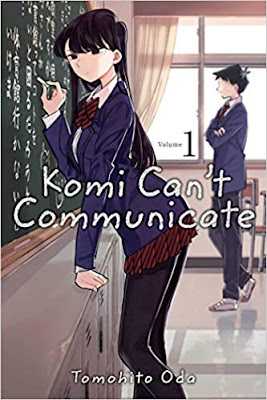I'm not a fan of shounen manga generally, and I was skeptical of the premise of Komi Can't Communicate vol. 1 (Viz): Komi is a beautiful, but alone, high-school girl who can't talk and her underwhelming classmate Tadano takes her under his wing to help her achieve her dream of making 100 friends. Yikes, that sounds like it could be fairly condescending to women. Further, while not a strict 4-koma, it is a comedy manga that is scripted in short comedic bursts, also not my preferred style. So I was pleased to discover that it was a well balanced, kind, and funny manga.
Komi is beloved by everyone for her beauty, her grace, and her aura of perfection. But no one really knows her because she doesn't talk (which ends up adding to her mystique as most people don't even realize she's not speaking). It turns out, whether from some speech issues or social anxiety (I'm not a speech pathologist, so I have no idea where this communication disorder is coming from), she doesn't talk in school at all, and any attempts to do so get barely a single sound or puff of air out. That hasn't hurt her popularity, but it has left her completely alone and without any friends.
Enter our leading man, Hitohito Tadano. He's a pretty average, under the radar guy, who botches a joke when introducing himself to classmates, gets put down by the popular kids, and is just trying to get by. He is the first to realize that Komi isn't some unapproachable model of perfection, but actually is a normal girl who just wants to make friends and has a big barrier. He befriends her, much to her delight, and then commences to help her make friends.
Throughout the volume, we follow as the two work together to introduce her to some people. Apparently the school is known for admitting students who all have various quirks. Each student we (and Komi and Tadano) meet have their own uniqueness.
The first student Tadano tries to connect with Komi is Najimi Osana. What is fascinating is that Osana identified as male (or at least presented as such) in middle school but is now presenting as female. Tadano struggles with which pronouns to use, but otherwise, Osana's gender isn't an issue. Instead of making Osana's gender non-conformity the main plot point of our interactions with them, it's their overly-outgoing personality that is the focus (and the actual "quirk" they present with). I think this is actually a small win for representation! We have a gender non-conforming teen whose plot doesn't revolve around their gender! And for a school filled with quirky people, the gender non-conformity isn't the "quirk" they were admitted for. Awesome.
The next person they try to befriend is Himiko Agari. She's nervous and stutters when she talks. At first she is scared that Komi is stalking her and as a result of that fear ends up overcoming another fear of her own (lesser of two evils, I guess). After she overcomes one fear (given that the other option was facing Komi), she feels so indebted to Komi that they become friends. Now Komi has three friends.
We also see a sweet, but brief, interaction between Komi and her dad which adds a cell phone to the plot. And it is through this cell phone that another side to Komi appears, much to Tadano's joy. We actually hear Komi speak! From here, some early romantic possibilities show themselves.
Even though the premise might be a bit unbelievable, it is carried through so well, that it works as comedy. My favorite moment was when Komi is asked to read in front of class, stands silently trying to get the first word out, and then teacher the "agrees" with her that reading aloud serves no purpose and makes everyone read silently instead. Just like everyone else who idolizes her, he is missing that the fact that it isn't that she is choosing not to speak, but that she can't speak. That moment took the shaky premise and made it fit within a complete world-view that explains how she got to high-school having never uttered a word publicly.
The volume consists of 18 short chapters. It's not a traditional 4-koma, but it has much of that feel. What's surprising to me was that despite being a shounen series about a boy who helps a voiceless girl, we don't get any hero or savior complex, we don't get Komi as some weak girl in need of saving. Instead, Komi has lots of agency and acts on her own, pushing herself forward at various points without Tadano. There was also no service at all. In all, it was pretty much just a simple, sweet, fun set of comedy stories about quirky people.
The art has a brisk, easygoing, and somewhat simple style. Characters have a lot of expressiveness, mostly funny faces. The character depictions have a certain stylized quality that separates this art from others and supports the overall tone of the series. While it isn't my favorite style of manga art, it is well suited to the subject matter and works quite well.
In all, this was a sweetly funny comedy manga. If that's your thing, you really might want to check this out. It gets a solid 7/10 with room to grow as we learn more about the characters and they have more chance to develop. Let's hope it takes that opportunity.
✩🚺


No comments:
Post a Comment
Remember: please talk about the work, and offer counter points to others' analyses but DO NOT ATTACK THE PERSON whose analysis you are countering. (no ad hominem comments) Thanks! <3